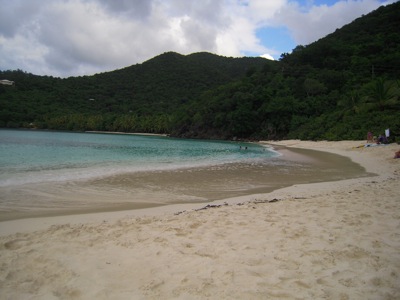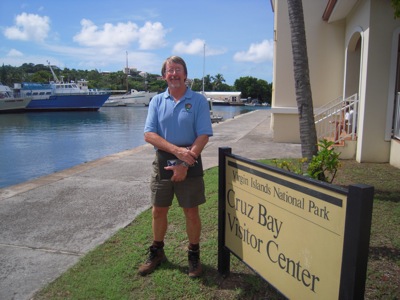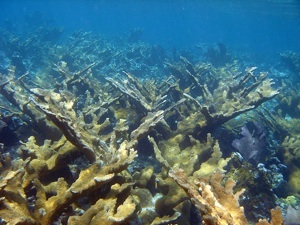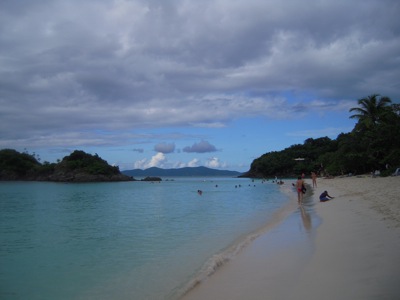
Preservation critical for park’s fragile reefs
CRUZ BAY, U.S. Virgin Islands— The unforgiving sun beats on my neck and back as I stretch my limbs and float above the water, head down, snorkel up, fins wailing in the picturesque sight that is Trunk Bay on the island of St. John.
As I gasp for air due to water bubbles creeping their way into my dive mask, I heard the far away shout of a lifeguard… “Hey, mind the corals, your fins…yours fins.”
“What was the big deal?” I thought.
 |
Hawknest Bay on St. John is home of the islands most pristine Acropora coral (Photo by Danielle Alvarez). |
I was attempting to stay as flat as possible and would not have come up if it wasn’t for that I could not breathe. I re-adjusted my mask, contorting my legs in the best way my life-long dance training allowed me and swam another few meters away from shore, remaining as horizontal as I could.
It was then that I understood the fuss. I opened my eyes to see a world that for one thing, did not belong to me. Yet unlike a museum, of which you can only mark your breath upon a thick glass wall that separates your averageness from a masterpiece, I was a part of the world, swimming only feet away from an endangered wonder, the fragile coral reefs of the U.S. Virgin Islands.
It felt as if I was spying into someone’s home while looking down on the vision of colorful mismatched organisms. Short, black and spiky creatures stood among what looked like giant purple fans. Thick, tan coral stood defiantly while fish swam and hid among them.
Flashes of bright turquoise, light blue, electric yellow and purple fluttered about, including certain fish that looked as if their outfits had been custom designed with their flashy and intricate scales. They swam uninterrupted through their world; not seeming to mind the small school of humans huddled above.
I couldn’t help but contemplate… Was I blocking their sunlight? Was I bothering them? Was my presence alone leading to their destruction?
They seemed unbothered, but before I could finish that thought, a smaller fish swam toward me, faced the opposite way and released a fairly large bubble of excrement. It became abundantly clear to me that maybe we weren’t supposed to be there and one tiny fish found it necessary to poop at me to let me know.
Coral reefs are intricate and precious creatures that although hard to not explore and admire, may just be deteriorating as a result of human temperament, such as in the U.S. Virgin Islands.
Fortunately, there are efforts being made to preserve them. Managers within the Virgin Islands National Park on St. John have been doing their part to protect these vital reefs, believing their efforts will help measure our ecosystems strength and/or fragility as “a thermometer of the world.”
According to a mission statement released by Park Superintendent Mark Hardgrove in 2007, The Virgin Islands Coral Reef National Monument was established in 2001 under the Clinton Administration, to designate 12,708 acres of federally owned submerged lands to preserve the Caribbean ecosystem.
| Virgin Island National Park Resource Manager Rafe Boulon stands in front of the park Visitor Center in Cruz Bay, an original mangrove site (Photo by Danielle Alvarez). |  |
Park Resource Manager Rafe Boulon said that coral reef bleaching is the biggest recent threat for the corals on the island. According to a disease fact document released by Boulon, record-high water temperatures in the summer of 2005, predicted to be caused by global warming, caused over 90 percent of the coral cover to be bleached. The actual bleaching is not the death threat for the reefs, it is the disease outbreak that pursues, primarily the “white plague,” that destroys the reefs.
Confused yet?
Basically, the whitening of the coral is caused when the host coral releases the single-celled algae due to stress such as warming waters. It is either regained or not, dependent on the severity of the stress.
The bleaching event destroyed two coral species that once contributed to the majority of the islands reef framework, the A. palmata and Montastraea annularis, the later of which declined to 40.9 percent from 55.6 percent as of 2007. The coral cover continued to decline through 2007, decreasing 61 percent even after water temperatures improved, proving the long-term destruction of these events.
Unfortunately, the bleaching event also harmed one of the island’s shoreline treasures, the acropora palmata. Bleached for the first time, the bleaching reached 50 percent of its colonies, with 15 percent dying entirely and 35 percent showing partial mortality. This specific Elkhorn coral (it resembles antlers) is found in shallow waters and therefore easily susceptible to damage.
 |
The best examples of Elkhorn coral are found in shallow waters such as those at Hawknest Bay on St.John. (Photo courtesy of Rafe Boulon and the Virgin Islands National Park). |
Today the best-preserved examples on the island are found off the shore of Hawknest Bay (I hope I didn’t blow their cover), where snorkelers can marvel in their beauty in a more secluded manner in comparison to the more frequently visited underwater trail at Trunk Bay. While visiting Hawknest, I did find that many snorkelers both respected the reefs they came to visit and were aware of their need for help.
“I love it here, so peaceful and beautiful. I am aware of the need for preservation, I think a lot of people are; the question is where they do anything or not,” said Florida resident and Hawknest Bay snorkeler, Jason Markee, 34.
Boulon further explained that damage is also brought upon the reefs through over- fishing, sediment buildup, nutrients released from tanks near the shore and anchor damage.
The park and surrounding island has seen improvement since the Virgin Islands National Monument was initiated in 2001, proving their tiny steps towards preservation are indeed covering ground. They enforce the depletion crisis in all printed park material and, fortunately, have recently attracted much attention from off-island news media.
“We are seeing an improvement in many areas. It still has a way to go, but only up form here,” Boulon said.
Park managers also encourage island youth to get involved in preservation and attempt to inspire those that will run island preservation efforts in the future through classroom visits on the island.
“I have even gotten complaints from parents after visits because children have gone home and reprimanded them for not helping,” said Boulon.
There are some locals that fear that the loss of coral may hurt the island economically.
“The main attachment is because we depend on them for tourism, without them, the people won’t come,” said native and Trunk Bay lifeguard Richard Penn Jr.
 |
Many visit Trunk Bay on St. John for the underwater coral reef trail to observe the island’s endangered gems (Photo by Danielle Alvarez). |
I couldn’t help but wonder…would a little less visiting not do some good for the coral… and the world in general?
The park is hoping to start an educational program throughout the island to include reminders for both visitors and locals with signs on the beaches and in underwater areas offshore along with higher fines, currently placed at only $250 for striking coral.
“If education doesn’t work, we might legally have to make many parts restricted,” said Boulon.
Spending time with local residents on the island, I came to see that many of them understood the need to protect their reefs and cared deeply for them.
While chatting with lifeguard Alberto Samuel on the shores of Trunk Bay, he spent time detailing one specific coral he has watched deteriorate to nothing in the past 10 years. It seemed that with every word he uttered in his story, recalling the piece of coral from his childhood, he was coming to the strong realization that a vital aspect of his island was withering away before him.
“Yeah, it is sad,” he paused. “But we do our part to help prevent more damage, we just can’t prevent everything.”
After speaking with Boulon, who would only feel comfortable responding to “Rafe,” and spending time with the locals on the island, I gained not only an understanding for a plethora of coral species and island landmarks, but came to understand the passion of the men and women that guard the park and its resources.
Rafe, as laid back as the word can describe, speaks in a voice synonymous to soothing crashing waves. As an island native, he lives and breathes the park. He, along with his team, are bonded to these endangered reefs and exhaust their efforts to keep them alive.
I, on the other hand, never recycle and drive my non-hybrid car around all day in a big city and even frivolously moved about my fins while feet away from the island’s coral. In contrast, they live on St. John (granted it is gorgeous) and spend their days protecting the reefs of the island and in doing so, our ecosystem and world. Talk about perspective.
I only hope my words do them justice.
Coral Reefs
Think the reefs are no big deal? Here are four things you need to know.
The importance of coral reefs:
- They provide homes for fish.
- Reef fish and mollusks feed 30-40 million people a year.
- They control the level of Carbon Dioxide on Earth.
- They protect our shores.
Can you think of a better reason to protect them? Visit http://nps.gov/viis/ to find out how you can help. Source: http://oceanworld.edu.
Visiting Trunk Bay:
- Entrance Fee: $4
- Getting There: Follow Route 20 for about three miles from Mongoose Junction to find the beach landmark. Every driver also knows the name and the location is a common stop on driver’s routes. There will be lines of cabs waiting outside to bring you back to town.
- Taxi: $5-$10 from Ferry Station.
- Food: A snack bar is open from 9 a.m. to 4:30 p.m., selling fried goodies and drinks.
- Gift Shop: The small shop sells beach day vitals, including sunscreen, towels and cameras. Snorkel equipment can be rented for under $15 (must be returned by 3 p.m.).
Visiting Hawknest Bay:
- Entrance Fee: Free.
- Getting There: Starting from the Mongoose Junction, the beach is located 1.8 miles east from the junction on Route 20. This beach is not a common stop for drivers, as it is less visited, so opt to rent a car for this visit or arrange a driver for drop-off and pick-up, just remember they drive on the left side of the road.
- Cab Fee: $10.
- Food/Shopping: There are no gifts shops or snack bars on this beach so pack whatever you will need for the day and enjoy the peace and quiet.

Comments are Closed